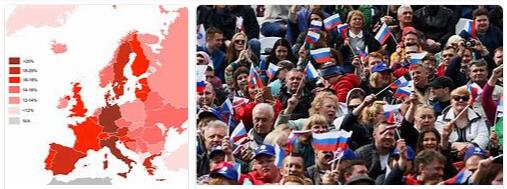Until 1988, emigration from the Soviet Union, the one that was tolerated or – even more rare – that clandestine, was a very limited phenomenon, affecting a few tens of thousands of people a year. The turning point of 1989 has perhaps increased the number of departures per year tenfold, but the catastrophic Western forecasts that foreshadowed a mass exodus from Russia have not yet occurred. Since 1993, the issuance of passports and freedom of expatriation have been ensured for all Russian citizens, but it is the West that has proved to be stingy for its part in granting entry visas. Moreover, for now, there are no premises for a strong Russian emigration. The demographic pressure, after the detachment of the Asian republics, is now zero in the country: the birth rate, which still reached 17ı in 1987, it is now in line with the lowest in Western Europe, with an average value of 11ı in 1992; the death rate has now overtaken it, reaching 12ı. With practically negative natural growth, rapid future aging of the population becomes inevitable; only a dramatic rise in unemployment, especially among young people, could therefore generate substantial flows of emigration. Everything depends, therefore, on the evolution of the economic conditions of Russia: a further reason, for Western countries, to concretely help this evolution.
At present, emigration from the Russia is essentially an ethnic fact. The emigration of citizens of the Jewish religion to Israel, already admitted with great limitations in the Soviet era, had a sharp rise with the liberalization of 1989-90, and continues today to a relatively strong extent, also due to a certain dangerous resurgence of anti-Semitism. To a lesser extent, Russians of German origin are emigrating (a peak occurred in 1991), and to an even smaller number citizens belonging to border minorities, of Polish, Greek, Finnish and Hungarian origin.
A particular aspect is represented by the emergence of a certain brain drain: qualified people, who have received adequate training in Soviet university structures and are able to aspire to well-paid positions in advanced industries or in research centers abroad. About 30,000 would have already emigrated in the three-year period 1990-92. This is certainly a problem, because it is an impoverishment of the elites Russian intellectuals could compromise the country’s economic evolution and generate new crises. There is also the problem, secondary but not negligible, of those numerous scientists and technicians of the military nuclear industry, who today have a strong probability of being underemployed in Russia, and could be attracted by offers of employment perhaps in unreliable countries.: also in this case, there are signs that the West, fearful of this prospect, is taking action to encourage the reconversion of these personnel at home for peaceful purposes.
Faced with this limited emigration, immigration currents in Russia coming from outside the old Soviet space are almost non-existent: they are identified with the return of a part of the not many exiles, fugitives or expelled in the decades of the Soviet regime, starting with A. Solženicyn. As a matter of curiosity, the repatriation of a hundred survivors, or their descendants, among the escaped nobles (zacritniki) at the time of the Bolshevik revolution. However, those movements that, although now equally international, remain within the context of the CIS must also be considered. In fact, since the mid-eighties (Gorbačëv’s coming to power) the return of some of the members of those ethnic groups that had been deported by Stalin under accusation of collaboration with the Nazis during the Second World War has been slowly taking place. Moreover, these movements concern Ukraine more (for example the return of the Crimean Tatars) or other republics, than Russia. Rather, the latter is grappling with the prospect of repatriation of Russians residing in other former Soviet republics, especially those living in countries at risk or in areas of ethnic conflict. A contrasted perspective, both for the countries of departure, which generally do not look favorably on a massive repatriation of Russian and Slavic minorities in general (which represent an important component of their economy), and for the Russia itself, for which it is a real problem dispose of jobs, and of the same homes, for a possible massive influx of returns. Figures released in 1992 speak of about half a million refugees up to then, especially from Tajikistan, Abhasia (Georgia) and Trans-Dnestr (Moldova).
